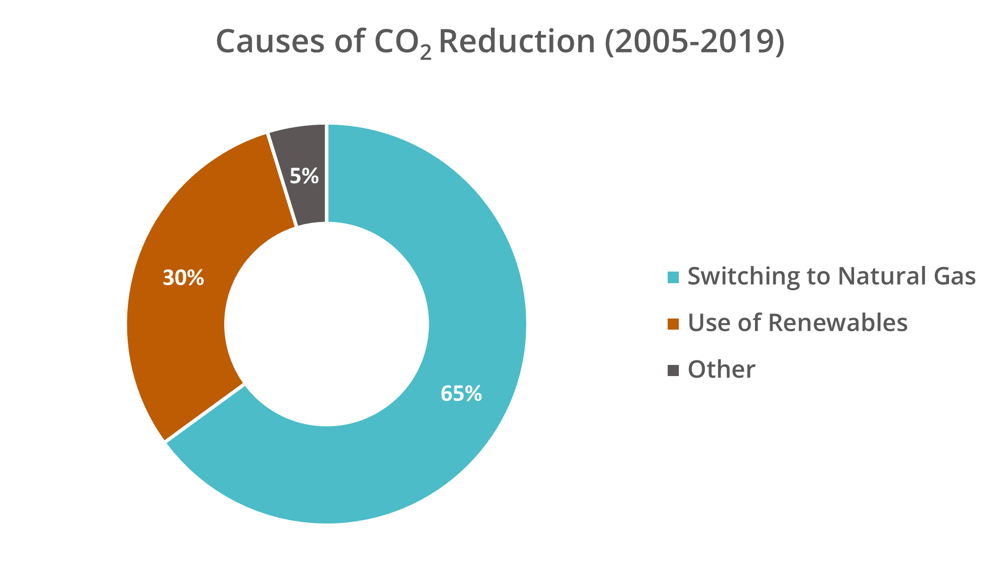May 31, 2023

Written By
Dhruv
You’ve been hearing it a lot: fossil fuels are on their way out and clean, decarbonized alternatives are in.
While there is some truth to this statement—renewable alternatives are becoming increasingly viable and more widely adopted—the narrative conveniently overlooks the enormity of such a transition.
The world's insatiable demand for energy requires a continued contribution from fossil fuels for the near future—and well beyond.
Throughout that lengthy transition, instead of being an either-or, it will be both.
Coal produces 209 lbs of CO2 per MMBTU of thermal energy generated, while Natural Gas produces 117 lbs of CO2 per MMBTU.
That’s a whopping 44% difference in greenhouse gas emissions.
The superior efficiency of natural gas fired power plants—especially combined-cycle plants—makes the difference even more stark when producing electricity.
Natural gas produces 976 lbs of CO2 per megawatt hour (MWh) while coal produces 2,260 lbs of CO2 per MWh—over twice as much.
Simply continuing to replace coal-fired power plants with gas-fired ones can slash our carbon footprint.
Between 2005 and 2019, switching generation from coal and oil to natural gas was responsible for 65% of the reduction in power-related CO2 emissions—more than twice as much as the increased use of renewables. 
Source: EIA
And CO2 emissions reduction isn’t the only benefit.
Coal is a major contributor to other forms of air pollution, including soot and particulate matter, Sulfur oxides (SOx) and Nitrogen oxides (NOx)—both major contributors to poor air quality and respiratory health issues.
When we discuss electrification, it is often from the perspective of it being green and less polluting.
While there is merit to this when focusing exclusively on renewables, we must not forget that most electricity is still generated by burning fossil fuels.
Since much of that combustion happens in large industrial facilities, we must also account for processing costs, generation losses, and transmission losses.
Electricity production by fossil fuel combustion is tertiary generation: fossil fuels are burned to release heat, which is used to convert water into steam, which is used to spin a turbine that converts motion into electricity.
Each of these stages has energy losses, as shown in the example below.
 For every 100 MMBTU of energy produced at the source, only 28 MMBTU is available for consumption in the form of hot water; 72% is wasted.
For every 100 MMBTU of energy produced at the source, only 28 MMBTU is available for consumption in the form of hot water; 72% is wasted.
As the world continues adding renewable generation, a large portion of these losses can be eliminated.
However, this will be a multi-decade process, which means that 70%+ of energy will continue to be wasted, resulting in higher costs to consumers, more emissions, and an ongoing demand for coal.
By comparison, natural gas is more efficient. For the same 100 MMBTU of energy at source, some 55% is available in the form of hot water, almost twice that of electricity transmission and electrical water heating.
 The bulk of losses now come from natural gas water heaters, which are less efficient than their electric counterparts. The same type of loss occurs in electricity generation, where waste heat is lost through the power plant exhaust.
The bulk of losses now come from natural gas water heaters, which are less efficient than their electric counterparts. The same type of loss occurs in electricity generation, where waste heat is lost through the power plant exhaust.
While electricity generation is undoubtedly valuable and necessary, there are more appropriate tools for some purposes.
Much as you wouldn’t repair a Rolex with a sledgehammer, using the right fuel for the right purpose can significantly reduce emissions, costs, and more.
We’ve discussed a few reasons why natural gas is such a valuable tool in our energy arsenal.
It has clear benefits over other fossil fuel options and is abundant and affordable.
It has contributed significantly to reductions in greenhouse gas emissions.
In a future post, we’ll explore how relying on natural gas also brings economic and stability benefits.
The answer to a complex problem like decarbonization will never be simple. We must keep an open mind and carefully evaluate our options at each step of the way.
Sometimes this will mean deploying one approach individually. At other times, solutions will work better in tandem.
At the macro level, instead of being an either-or, it's undoubtedly both.
Tags: Energy Transition

The natural gas industry plays a pivotal role in the global energy landscape and is set to continue doing so for decades. As a cleaner alternative to coal and oil, it represents a crucial bridge in...

As a company that specializes in the management of natural gas trades and transactions, we’re fascinated by the molecule that makes up 70-90 percent of natural gas: methane. Larger, more complex...
© 2023-2026 Trellis Energy Software, Inc. | Terms of Use | Privacy Policy | Mailing Address